danbricklin.com/log
|
||
|
|
Starting October 24, 2001
Boston History Makers awards, Comdex pictures, I'm not at Comdex, On Building Systems That Will Fail, Techies vs. Telcos, Web services and storage, Paul Simpson, Extending a happy event
24Oct01-15Nov01
2001_10_24.htm
|
|
Thursday, November 15, 2001
Boston History Makers awards
Tuesday night I attended the 2001 History Makers Awards given by the Boston History Collaborative. As I mentioned last July, I'm on the Honorary Board. They sponsor, among other things, the Innovation Odyssey -- a wonderful bus tour of Boston where an actor puts on skits chronicling some the innovations that happened in Boston. They include using ether for surgery (they stop at Mass. General's Ether Dome), the mutual fund, the electronic spreadsheet
This year's awards went to Gillette (the disposable razor blade), MIT, Genuity (the Internet service spinout from BBN for its role in the ARPAnet/Internet), Genzyme (biotech solutions to certain health disorders), and the Boston Red Sox (in honor of their 100th anniversary and winning the first World Series in 1903). Frank Ridley, the talented actor who conducts the tours, put on skits about smallpox and learning about vaccination from a slave brought over from Africa, the invention of Gillette's razor, the early ARPAnet, and the first World Series. Really good.
The award to Boston-based Gillette was given by John Kenneth Galbraith. He's in his 90's but still gave a great introduction, with humor and a twinkle in his eye. (A tour of Gillette many years ago had a major influence on his views of companies.) I sat at a table with the Internet people along with Joyce Plotkin and Bruce Holbein of the Massachusetts Software and Internet Council. I spent most of dinner talking with Dave Walden about old times and current problems (which I cover here frequently). Here are some pictures:
 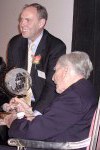   John Kenneth Galbraith speaking, giving the award to Gillette president Edward DeGraan, actor Frank Ridley starting one of his skits, Ray Stata of Analog Devices giving the award to MIT president Charles Vest
 Internet pioneers representing BBN's contribution: Frank Heart (who led the team), Ray Tomlinson (who sent the first email over the ARPAnet, choosing "@" to separate name from domain), Leo Beranek (the second "B" in BBN), David Walden (a member of the original team), and Alex McKenzie (who ran the first network control center, among other things).
Comdex pictures
Here are some of the Comdex pictures that Bob Frankston brought back. No hardware stuff, just a few from the PC Magazine Technical Excellence Awards. Michael Dell received the Lifetime Achievement Award. Bob and I received it jointly 10 years ago -- as a sign of the times, they don't wear tuxedos anymore. Michael Dell and Bill Gates (standing in for vacationing "Person of the Year" Jim Allchin) didn't even wear a tie. [Ten years ago, we had to bring tuxedos and wait for a limo to take us to the event. What a fantasy! We were brought back by limo and then got to walk through the casino. As I walked up to the gambling tables I felt just like I was in a James Bond movie. The feeling didn't last long. Everybody else was wearing jeans or Bermuda shorts. I felt quite silly with my bow tie and quickly left to go to bed.]
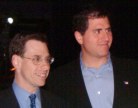 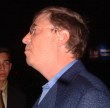 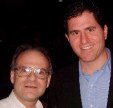 PC Mag's Michael Miller with Michael Dell, Bill Gates, Bob Frankston with Michael Dell
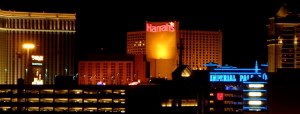 The view outside in Las Vegas (Photos courtesy of Bob Frankston)
Tuesday, November 13, 2001
I'm not at Comdex
Here it is, Tuesday of Comdex week, and I'm still home. For the fourth time (the first two shows, and one more than 10 years later in the 1990's) I'm missing the big trade show. Trellix is selling to companies that don't go there, and I've been to lots of recent conferences where I got to see many of the other people I need to. So, no direct business reason to send me. Too bad. I miss it but skipping it was much better for my schedule so I didn't try figuring out other reasons to go. I spent 85 minutes watching the online video of Bill Gates' keynote yesterday. A lot easier than waiting in line for hours. On the other hand, I didn't get to schmooze at the parties.
Tuesday, November 6, 2001
On Building Systems That Will Fail
There are constant reports of problems with systems we build. We're also talking about building all sorts of complex new systems to "protect" things in light of the change in attitude brought about by the events of 9/11. Serendipitously, I ran across a talk given in 1991 by a professor (and boss) who had a big influence on my career and implementation style, Prof. Fernando J. Corbató. It was his lecture upon receiving the ACM's 1990 Turing Award. It's worth looking at 10 years later: Read "On Building Systems That Will Fail".
 Prof. Corbató, the "father of timesharing", from my LCS 35th Album
He writes:
What I am really trying to address is the class of systems that for want of a better phrase, I will call "ambitious systems." It almost goes without saying that ambitious systems never quite work as expected. Things usually go wrong and sometimes in dramatic ways. And this leads me to my main thesis, namely, that the question to ask when designing such systems is not: "if something will go wrong, but when will it?"
These are good things to think about as we put together new incredibly complex and ambitious systems built out of web services. Corby brings up lots of interesting examples to learn from, including driving through Boston rotaries and the progression of events that led to the incident that dramatically taught us to keep password files encrypted at all times on disk.
Friday, November 2, 2001
Techies vs. Telcos
Here's more from the Agenda conference: David Kirkpatrick wrote an article in Fortune Magazine titled "Great Leap Forward: Techies vs. Telcos". It's a two-page article (on the web, soon in print) that explains why many people feel there should be a split made between connectivity providers and content providers. For more background, you can read Bob Frankston's essay "Beyond Telecom". I think this is important stuff.
Monday, October 29, 2001
Web services and storage
I just posted another essay: "Web Services, Business Models, and Storage". It examines the role of who controls storage in the success or failure of Web services, and the difference between being a "product" vs. a "service". I'm concerned that the move to services could be bad for innovation because of the advantage it gives to established companies. In addition, I see a danger that a lot of development money is going into architectures that customers will be wary of supporting. Finally, I see this issue explaining some of the lure of Peer-to-Peer architectures.
Friday, October 26, 2001
Paul Simpson
One of Trellix's longtime employees has started doing consulting for others, and I thought I'd let people know about it. Paul Simpson was hired early on in the company's history to form and lead our customer support organization. He did a superb job, eventually bringing it to a vice presidential position. We won all sorts of awards and constant accolades from customers for our support web site and online support. Paul himself won "Support Professional of the Year" in 1998 from the Association of Support Professionals. After we switched from the prepackaged client-side software world to the private label server-based world we went from lots of front-line support to just a little second-line support. At that point, Paul left Trellix.
 A picture of Paul from last Halloween, when many people at Trellix dressed in plaid flannel shirts and jeans to look like me...
Wednesday, October 24, 2001
Extending a happy event
This past weekend I attended the wedding of a close friend. My parents came up from Philly to attend, too. It was a joyous event. As a gift to the families involved in the wedding, I decided to take some pictures and post them on the web. They really appreciated it, as have friends and families involved in other such events I've documented. By having many pictures available to share by the next morning, people get to relive the event and share it with others who couldn't make it. Some have even told me they'd be at the dentist who'd say "So, how was the wedding?" They'd be able to reply, "Do you have a browser on that computer? Let me show you..." Don't underestimate the joy this sharing and reliving brings to people. In these times with a cloud of sorrow, maximizing and sharing joy is a good thing.
If you have a digital camera, take lots of pictures (they can be low resolution -- they're for the web and you're not competing with the official photographer) and post them. It helps to have some text, but just breaking them into a few pages ("Preparation", "Ceremony", "Party") may be all that is necessary. The important thing is to share it quickly, so you can help them prolong the event.
I found that following some of the ideas in my Web Photo Journals web site, especially the one about cropping, really helps. My mother, who helped me choose the pictures, kept remarking how doing the cropping turned pictures from ordinary and unflattering into good shots. Take the time to crop -- it really pays off, especially on the web. I also try hard to keep the posted sizes down (knowing many of the viewers will be using dial-up lines), and cropping lets you remove extraneous parts of the image. I like to include wide pictures, cropped from the top and bottom, to show lots of people, too. It's like I did last summer at the IBM PC Anniversary:
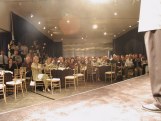 Full shot last summer -- 161x121 = 19,481 pixels
Cropped -- 391x45 = 17,595 pixels
Taking lots of pictures increases the likelihood of having good ones. (Why do you think professionals take so many pictures when only one will end up in the newspaper?) Also, by taking lots of pictures you can show lots of people, lots of ambiance, and lots of what it was like. With digital, it really doesn't cost much to take what would cost $50 or more if it was film. For this wedding I took 124 pictures, most relatively low resolution (1280x960 = 1.2 megapixels), totaling 24MB (I used at 32MB card in the camera). The web site took a couple of hours to build (using the old Trellix Web 2.7) and takes up about 1MB on the web server, including 80 pictures -- something very accessible by modem.
Before I left the wedding, I made sure to get the email address of the parents of the bride and groom, and a couple of others.
I almost didn't bring my camera, but at the last minute I decided making a quick web site was a treat I really should share, and since I knew how and had the tools, I really should do it. I write this here to push you readers who know how and could do it to do the same. Some people know how to play popular tunes on the piano so we can all sing along, others know how to take pictures and make web sites...
So, do the bride and groom and others a favor: Take lots of digital pictures, post them right away, send an email to a few people with the URL who will contact others, and bring a smile to lots of faces.
|
||
|
© Copyright 1999-2018 by Daniel Bricklin
All Rights Reserved.
|
||